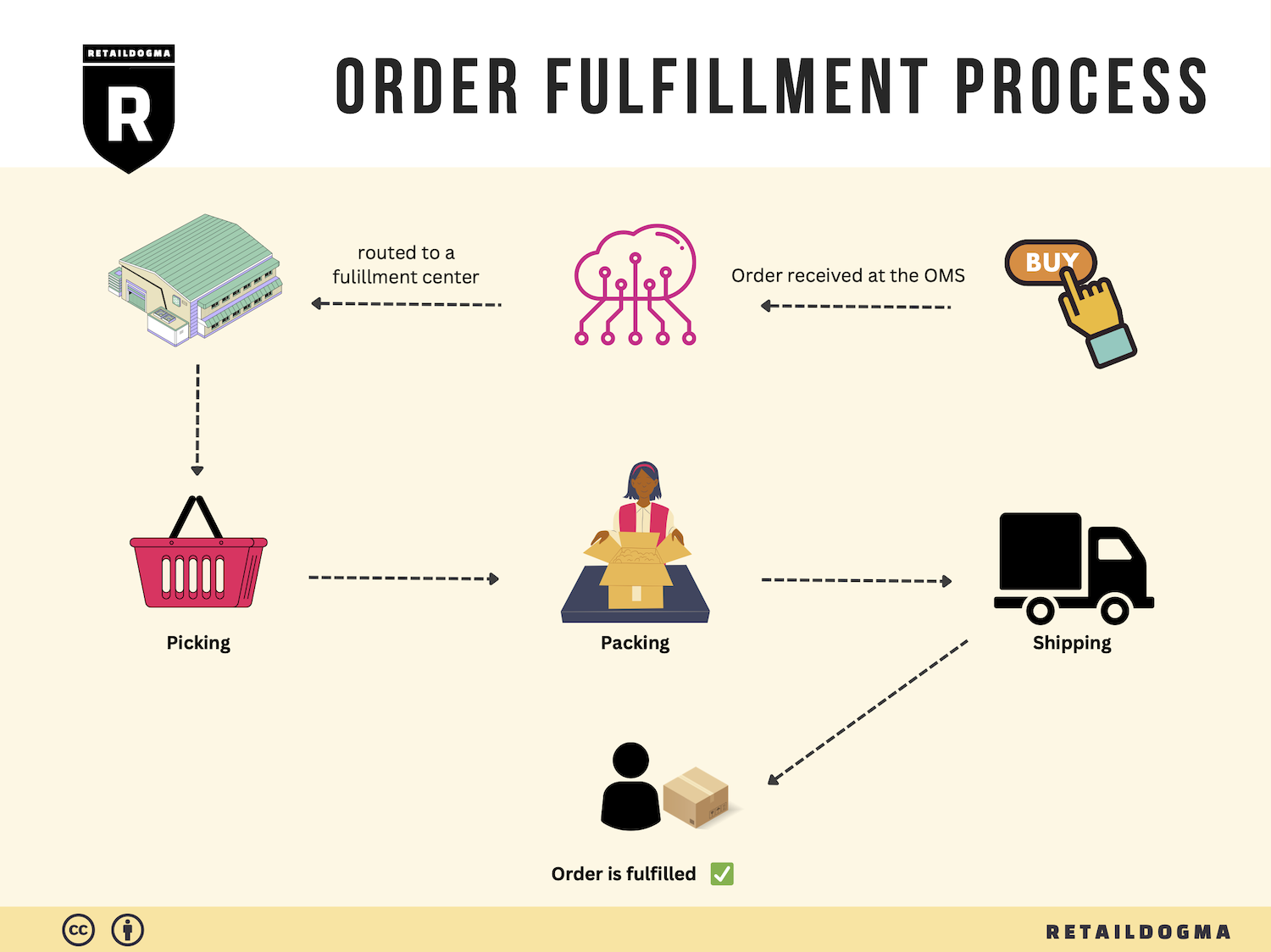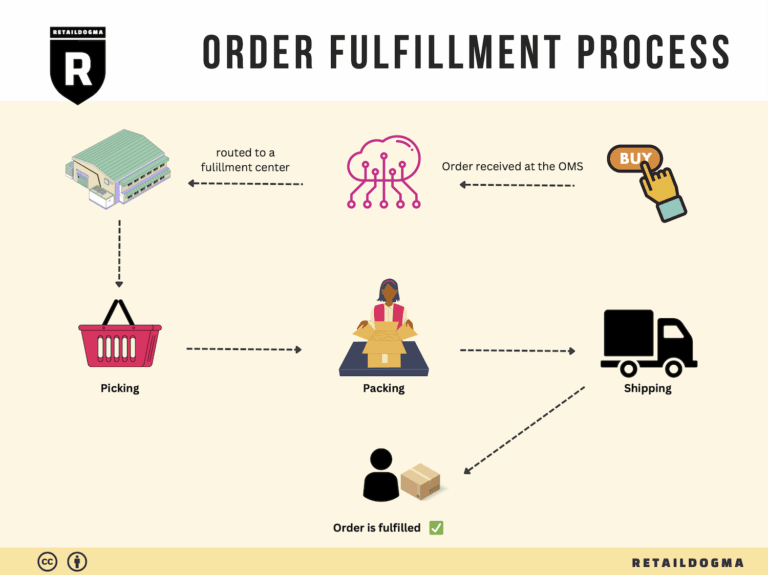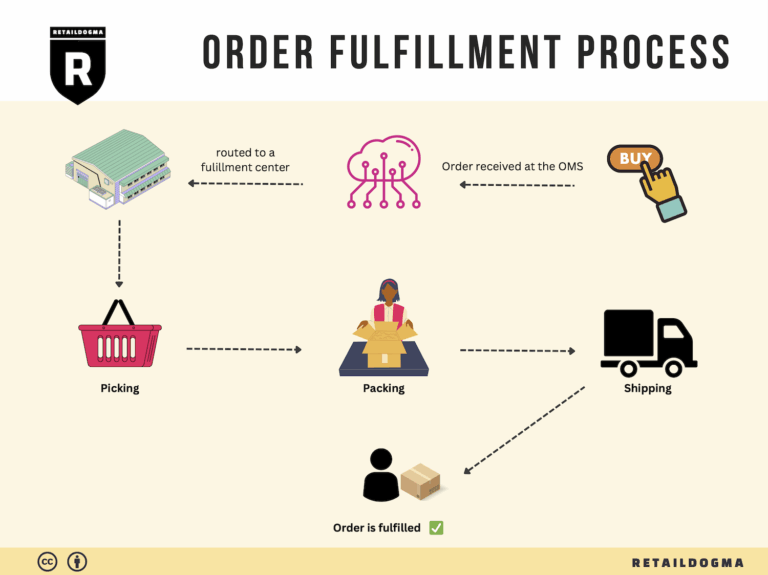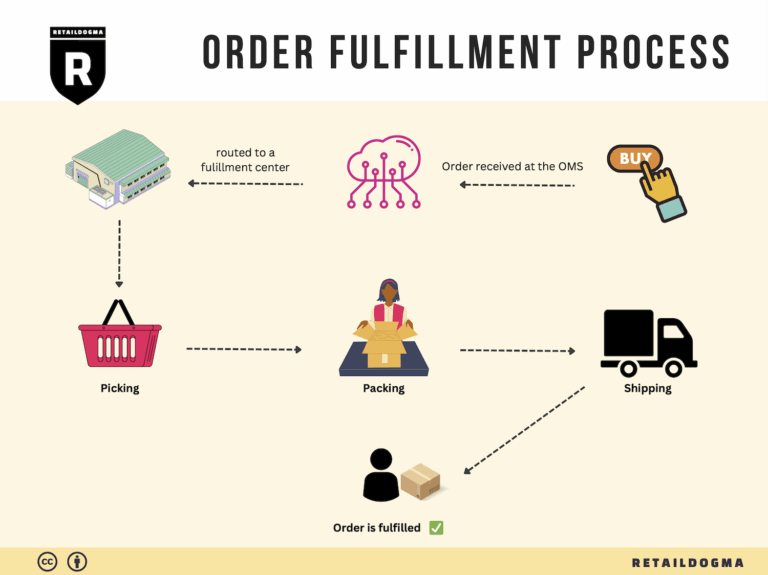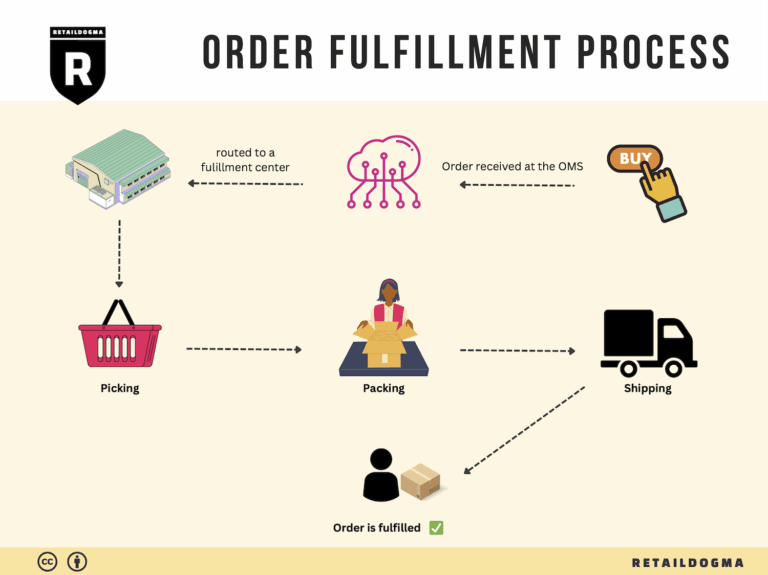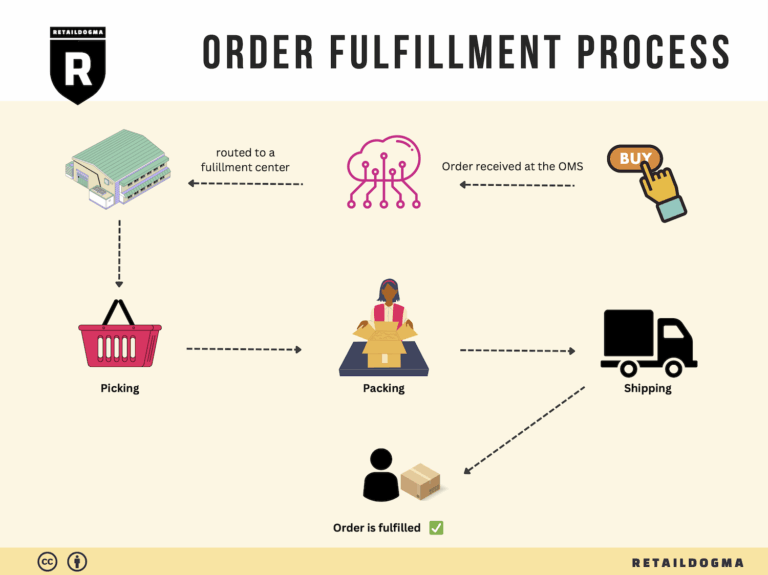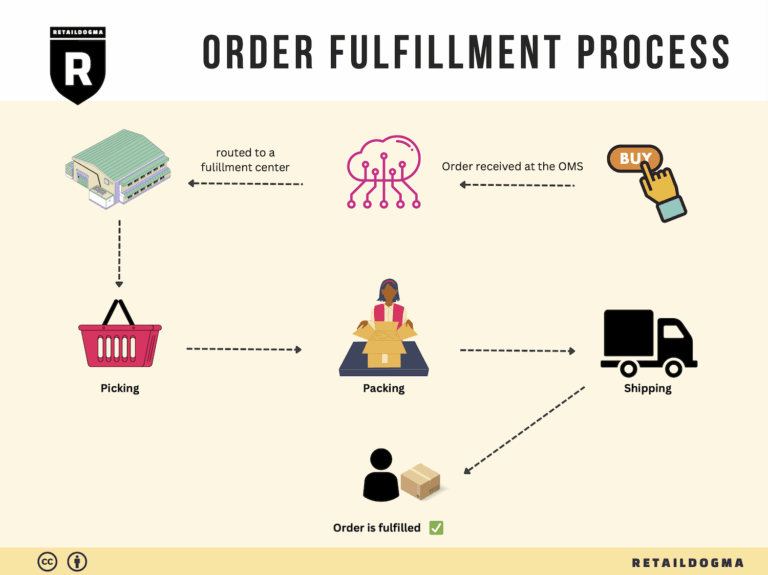Ecommerce Fulfillment Services: The Ultimate Guide (2025)
What is E-commerce Fulfillment? An Introduction for Growing Businesses
Understanding the Fulfillment Challenge
As an e-commerce business owner, you may find yourself grappling with the complexities of packing and shipping orders. The exhilaration of a sales spike can quickly turn into a logistical nightmare, leaving you overwhelmed with the sheer volume of orders. This is a common pain point for growing online businesses: how to efficiently manage the fulfillment process without compromising on customer experience or straining your resources.
What is E-commerce Fulfillment?
At its core, e-commerce fulfillment is the process of getting a product from your warehouse or fulfillment center to your customer’s doorstep. This involves several key steps, including inventory management, order processing, picking and packing, shipping, and handling returns. The fulfillment process can significantly impact your business’s efficiency, customer satisfaction, and ultimately, your bottom line.
What This Guide Covers
In this comprehensive guide, we will delve into various aspects of e-commerce fulfillment to help you navigate this critical component of your business. Here’s what you can expect:
-
Different Fulfillment Models: We will explore various fulfillment models, including Third-Party Logistics (3PL) and Fulfillment by Amazon (FBA). Understanding these options will help you determine which model aligns best with your business needs and growth plans.
-
Core Fulfillment Services: We’ll outline the essential services involved in the fulfillment process, such as inventory management, order processing, and shipping. You’ll gain insights into what services you should prioritize when selecting a fulfillment partner.

-
Choosing the Right Partner: Selecting a fulfillment partner is a crucial decision for any growing business. We will provide practical tips on what to look for in a fulfillment provider, including technology capabilities, scalability, and customer service.
-
Pricing Considerations: Finally, we’ll break down the various pricing structures associated with e-commerce fulfillment. Understanding these costs will empower you to make informed decisions that can enhance your profitability.
Empowering Your Business Decisions
The ultimate goal of this guide is to equip you with the knowledge and tools necessary to make smart decisions about your logistics. By understanding the nuances of e-commerce fulfillment, you can streamline your operations, improve customer satisfaction, and position your business for sustainable growth. Let’s dive in and transform your fulfillment challenges into opportunities for success.
What You’ll Learn In This Guide
- What is E-commerce Fulfillment? An Introduction for Growing Businesses
- The Order Fulfillment Process: From ‘Buy’ Button to Customer’s Door
- Comparing Fulfillment Models: In-House vs. 3PL vs. Dropshipping
- A Deep Dive into Amazon FBA: Pros, Cons, and Who It’s For
- Core Services Offered by Fulfillment Centers
- How to Choose a Fulfillment Partner: A 6-Point Checklist
- Understanding Fulfillment Pricing: A Breakdown of Common Fees
- Frequently Asked Questions (FAQs) about Fulfillment
- Conclusion: Is Outsourcing Fulfillment the Right Move for Your Business?
- Important Disclaimer
The Order Fulfillment Process: From ‘Buy’ Button to Customer’s Door
1. Receiving Inventory
The first step in the order fulfillment process is receiving inventory. This involves checking the incoming goods against purchase orders to ensure accuracy and quality. Each item is assigned a unique identifier, commonly referred to as a Stock Keeping Unit (SKU), which is crucial for tracking inventory throughout the fulfillment process.
Importance: Accurate receiving is vital to maintain inventory integrity. Any discrepancies at this stage can lead to stockouts or excess inventory, both of which can adversely affect customer satisfaction and operational efficiency. Furthermore, a robust receiving process helps to establish a reliable baseline for inventory management.
Key Term: SKU (Stock Keeping Unit) – a unique identifier for each product that facilitates tracking and management within the warehouse.
2. Warehouse Storage
Once inventory is received, it is organized and stored in the warehouse. This step involves categorizing products based on their type, size, and demand frequency. Efficient storage solutions can include shelving units, pallet racks, or bins, depending on the product characteristics.
Importance: Proper warehouse storage is essential for optimizing space and ensuring quick access to products. The layout should be strategically designed to minimize travel time for warehouse staff during the picking process. A well-organized storage system not only enhances operational efficiency but also reduces the risk of product damage and misplacement.
Key Term: FIFO (First In, First Out) – a method of inventory management where the oldest stock is sold first, ensuring product freshness and reducing waste.
3. Order Picking
Order picking is the process of retrieving items from storage based on customer orders. Warehouse staff use pick lists—documents that specify the items and quantities needed for each order—to guide their picking activities. This step can be executed using various methods, including single order picking, batch picking, or zone picking.
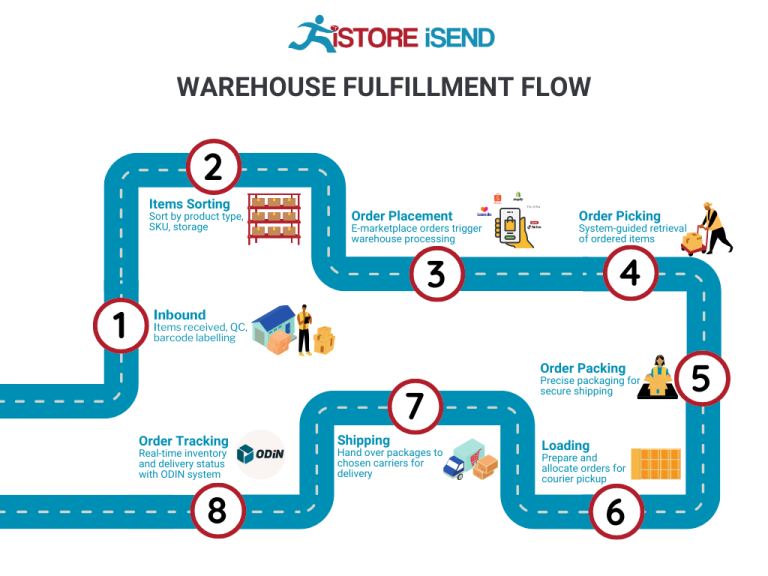
Importance: Efficient order picking directly impacts delivery speed and accuracy. The faster and more accurately orders are picked, the higher the level of customer satisfaction. This step is crucial for meeting the demands of e-commerce businesses, especially during peak seasons where order volumes can surge.
Key Term: Pick List – a document that outlines the items to be gathered from the warehouse for fulfilling a specific order.
4. Order Packing
After items are picked, they move to the packing station, where they are prepared for shipping. This step involves verifying the picked items against the order details, packing them securely in appropriate materials, and labeling them for delivery. Additional services, such as gift wrapping or including personalized notes, can also be performed during this phase.
Importance: Order packing is critical for ensuring that products arrive at the customer’s door in perfect condition. Proper packing minimizes the risk of damage during transit and enhances the overall customer experience. Furthermore, well-packed orders can reduce shipping costs by optimizing package size and weight.
Key Term: Packing Slip – a document included in the package that lists the items shipped and serves as a confirmation of the order.
5. Shipping & Delivery
The final step in the fulfillment process is shipping and delivery. Once packages are packed, they are handed over to shipping carriers for delivery to the customer. This phase involves selecting the most cost-effective and timely shipping options, often facilitated by technology that compares carrier rates and delivery times.
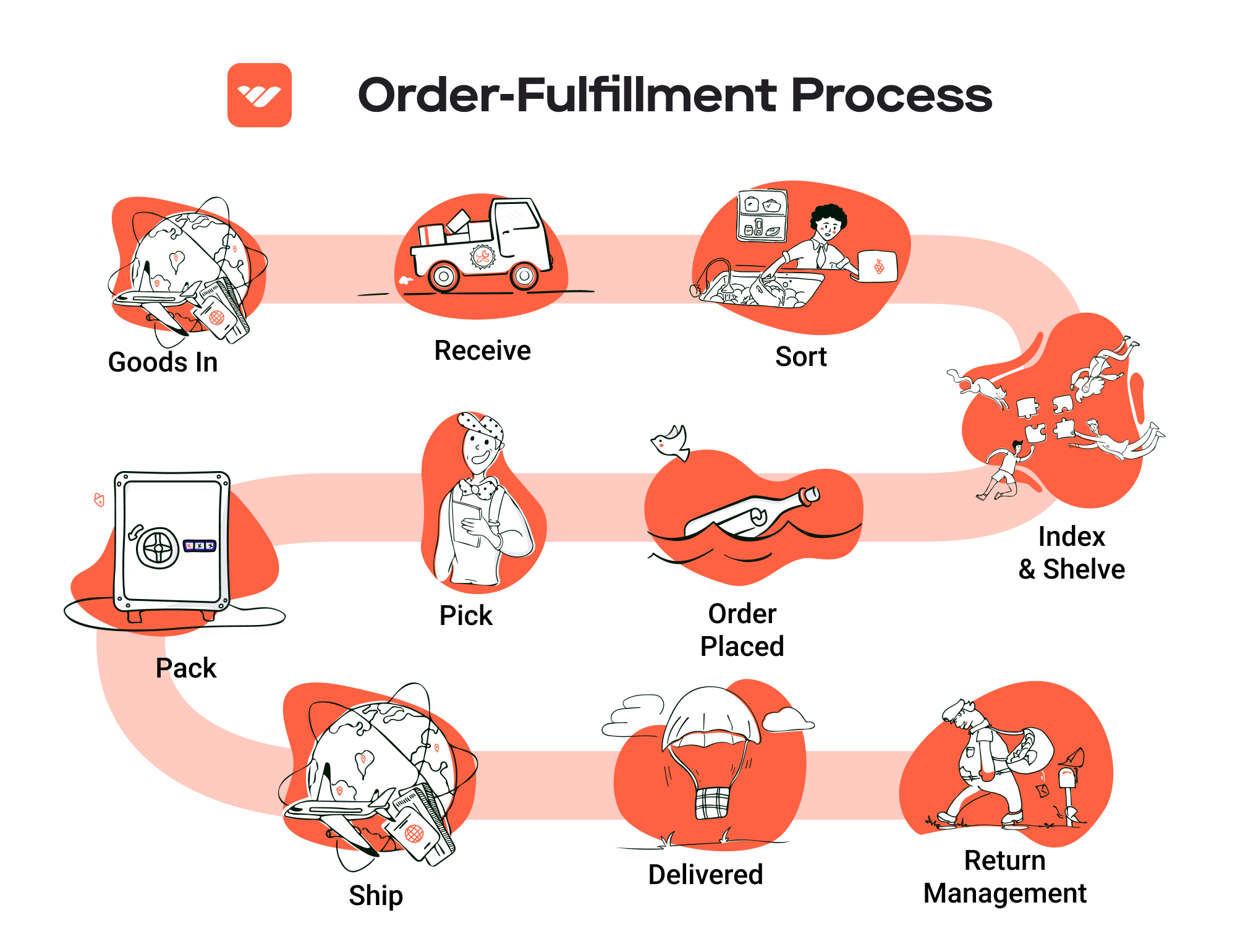
Importance: Timely shipping is crucial for customer satisfaction, particularly in the competitive e-commerce landscape. Businesses must balance speed and cost-effectiveness to meet customer expectations while maintaining profit margins. Efficient shipping processes also help to build customer loyalty and encourage repeat purchases.
Key Term: Rate Shopping – a method used to evaluate and select the most economical shipping carrier based on package dimensions, weight, and destination, ensuring cost-effective delivery.
By understanding and optimizing each of these five steps in the order fulfillment process, e-commerce businesses can significantly enhance their operational efficiency, reduce costs, and ultimately improve customer satisfaction. The integration of technology and best practices at each stage is essential for scaling operations effectively in the dynamic world of online retail.
Comparing Fulfillment Models: In-House vs. 3PL vs. Dropshipping
Fulfillment Model Comparison Table
| Model | Who Handles Inventory | Best For (Business Stage) | Key Advantage | Key Disadvantage |
|---|---|---|---|---|
| In-House Fulfillment | Business itself | Startups to mid-sized firms | Greater control over inventory | Higher overhead costs and complexity |
| Third-Party Logistics (3PL) | Third-party provider | Growing businesses | Scalability and expertise | Less control over logistics and inventory |
| Dropshipping | Supplier | New businesses or niche markets | Low startup costs and minimal risk | Lower profit margins and reliance on suppliers |
In-House Fulfillment
In-house fulfillment involves managing the entire order fulfillment process internally, which means the business itself is responsible for storing, packing, and shipping inventory. This model is particularly advantageous for startups and mid-sized firms that want greater control over their inventory and customer experience. By handling fulfillment in-house, businesses can customize their packaging, streamline processes, and ensure quality control directly. Additionally, in-house fulfillment allows for better integration with existing operations, which can lead to improved efficiency and responsiveness. However, this model comes with higher overhead costs, including warehouse space, staffing, and technology investments. As order volumes grow, the complexity of managing logistics increases, which can strain resources and divert focus from core business activities.
Third-Party Logistics (3PL)
Third-party logistics (3PL) is a fulfillment model where businesses outsource their logistics operations to specialized providers. 3PLs handle everything from inventory management and warehousing to packing and shipping. This model is ideal for growing businesses that need to scale quickly without the burden of managing logistics internally. By partnering with a 3PL, companies can leverage the provider’s expertise, technology, and infrastructure, allowing them to focus on marketing and sales. 3PLs often offer cost savings through established shipping relationships and operational efficiencies. However, the trade-off is that businesses may have less control over their inventory and logistics processes, which can lead to challenges in maintaining brand consistency and customer satisfaction. Additionally, reliance on a third-party provider means that any service issues or delays are ultimately out of the business’s hands, which can impact customer experience.
Dropshipping
Dropshipping is a fulfillment model where the retailer does not hold inventory but instead relies on suppliers to fulfill orders directly to customers. This approach is particularly attractive for new businesses or those targeting niche markets, as it requires minimal upfront investment and significantly reduces financial risk. Retailers can offer a wide range of products without the need for warehousing, allowing for greater flexibility in product offerings. Furthermore, dropshipping enables entrepreneurs to test markets and product viability without committing to large inventories. However, dropshipping has its downsides, including lower profit margins due to reliance on suppliers and potential issues with product quality and shipping times. Additionally, since retailers have less control over inventory levels and fulfillment processes, they may face challenges in managing customer expectations and ensuring a consistent brand experience.
Conclusion
Choosing the right fulfillment model is crucial for e-commerce businesses looking to scale. Each model has its unique advantages and challenges, making it essential for business owners to assess their specific needs, resources, and growth strategies. In-house fulfillment offers control and customization, 3PL provides scalability and expertise, while dropshipping allows for low-risk entry into the market. By understanding these differences, entrepreneurs can make informed decisions that align with their operational goals and customer expectations.
A Deep Dive into Amazon FBA: Pros, Cons, and Who It’s For
Understanding Fulfillment by Amazon (FBA)
Fulfillment by Amazon (FBA) is a service offered by Amazon that allows e-commerce sellers to store their products in Amazon’s fulfillment centers. In turn, Amazon takes care of storage, packaging, and shipping of products directly to customers. This service not only provides logistical support but also offers sellers access to Amazon’s vast customer base, enabling them to scale their business efficiently.
How FBA Works
-
Inventory Storage: Sellers send their products to Amazon’s fulfillment centers. Once the products arrive, they are stored in Amazon’s warehouses until they are sold.
-
Order Processing: When a customer orders a product, Amazon handles the entire process. This includes picking the item from the warehouse, packing it, and shipping it directly to the customer.
-
Customer Service and Returns: Amazon also manages customer service inquiries and returns on behalf of the seller, allowing businesses to focus on other aspects of their operations.
-
Prime Eligibility: Products fulfilled through FBA are automatically eligible for Amazon Prime, which provides significant advantages in terms of visibility and customer trust.
-
Multi-Channel Fulfillment: Sellers can use FBA to fulfill orders from other sales channels, including their own websites, allowing for a seamless logistics operation.
Pros of Using FBA
1. Prime Eligibility
One of the biggest advantages of FBA is that products become eligible for Amazon Prime, a program that offers free two-day shipping to millions of members. This can significantly boost sales, as Prime members tend to favor products that offer this benefit.
2. Increased Customer Trust
Amazon is a well-established brand known for its customer service. By utilizing FBA, sellers can leverage Amazon’s reputation, which can enhance customer trust and lead to higher conversion rates. Customers feel more secure purchasing items that are backed by Amazon’s fulfillment and return policies.
3. Multi-Channel Fulfillment
FBA isn’t limited to Amazon sales. Sellers can use FBA to fulfill orders from other platforms such as eBay, Shopify, or their own websites. This flexibility allows businesses to streamline their logistics operations while maintaining a presence across multiple sales channels.
4. Scalability
FBA allows sellers to scale their operations without the headaches associated with managing their own warehousing and shipping logistics. As demand increases, sellers can simply send more inventory to Amazon’s fulfillment centers.
5. Simplified Logistics
Outsourcing fulfillment to Amazon means less hassle for sellers. Amazon handles storage, packing, shipping, and customer service, allowing business owners to focus on marketing, product development, and other core activities.
Cons of Using FBA
1. High Fees
FBA can be expensive. Sellers incur various fees, including storage fees for keeping products in Amazon’s warehouses and fulfillment fees for each order processed. These costs can eat into profit margins, especially for low-priced items.
2. Strict Inventory Rules
Amazon has strict inventory management policies. Sellers must adhere to these rules regarding how much inventory they can send to fulfillment centers and how they manage their stock. Poor inventory management can lead to additional fees or even account suspension.
3. Commingling Risks
FBA employs a commingling process where products from different sellers are stored together. This can lead to issues where returns or customer complaints may affect a seller’s reputation if products are incorrectly attributed to them. Sellers may also receive returns that do not belong to them.
4. Limited Control Over Customer Experience
While Amazon handles customer service, sellers lose some control over the customer experience. Issues such as packaging quality and shipping speed are in Amazon’s hands, which can vary and may not always align with a seller’s brand image.
5. Competition
Using FBA means competing with other sellers, including those who may offer similar products at lower prices or with better marketing strategies. Standing out in a crowded marketplace can be challenging.
Who is FBA Best For?
Fulfillment by Amazon is best suited for e-commerce businesses looking to scale quickly and efficiently without the complexities of managing logistics in-house. It is particularly advantageous for:
-
Small to Medium-Sized Businesses: Companies that may not have the resources to manage their own warehousing and shipping can benefit from FBA’s comprehensive services.
-
Sellers with High Volume: Businesses that anticipate a high volume of sales, especially during peak seasons, can leverage FBA to handle the increased demand without overextending their operations.
-
Brands Seeking Prime Visibility: Sellers looking to tap into the Prime member market will find FBA essential for increasing their sales potential.
-
Multi-Channel Sellers: Businesses selling on multiple platforms can benefit from FBA’s ability to fulfill orders from various sources, streamlining their logistics.
In conclusion, while FBA offers a robust solution for many e-commerce sellers, it is important to weigh the pros and cons carefully. By understanding how FBA fits into your overall business strategy, you can make informed decisions that will help scale your operations effectively.
Core Services Offered by Fulfillment Centers
Inventory Management & Warehousing
Inventory management and warehousing are foundational services provided by fulfillment centers. This involves the systematic tracking of stock levels, orders, sales, and deliveries, combined with the physical storage of products in a secure and organized manner. Fulfillment centers utilize advanced technology and software systems to monitor inventory in real-time, ensuring that stock levels are optimized to meet customer demand without overstocking or stockouts.
Benefits:
1. Optimized Stock Levels: Effective inventory management helps prevent lost sales due to stockouts while minimizing excess inventory that can lead to increased holding costs.
2. Increased Efficiency: By using automated systems for tracking and managing inventory, fulfillment centers can streamline operations, reduce manual errors, and improve order accuracy.
3. Flexible Storage Solutions: Fulfillment centers often provide scalable warehousing options, allowing e-commerce businesses to adjust their storage needs based on seasonal demand or growth.
4. Enhanced Data Insights: With comprehensive reporting tools, businesses can gain insights into sales trends, inventory turnover rates, and seasonal fluctuations, enabling informed decision-making.
Pick and Pack Services
Pick and pack services are crucial for the order fulfillment process. This service involves selecting the ordered items from the warehouse, packing them securely for shipment, and preparing them for delivery to the customer. Fulfillment centers employ skilled staff and sophisticated technology to ensure that orders are picked accurately and efficiently.
Benefits:
1. Speed and Accuracy: Efficient pick and pack processes reduce the time it takes to fulfill orders, which is vital for maintaining customer satisfaction, especially during peak shopping seasons.
2. Customization Options: Many fulfillment centers offer specialized packing services, such as gift wrapping or including personalized notes, which can enhance the customer experience and strengthen brand loyalty.
3. Reduced Operational Burden: Outsourcing pick and pack operations allows e-commerce businesses to focus on core activities like marketing and product development, rather than the complexities of order fulfillment.
4. Scalability: As order volumes fluctuate, fulfillment centers can quickly adapt their pick and pack operations to meet changing demands, ensuring that businesses can scale without significant overhead.
Kitting and Assembly
Kitting and assembly services involve grouping multiple products into a single package or preparing products for sale through assembly. This can include bundling related items together or assembling components into a final product. Fulfillment centers often offer these services to help e-commerce businesses create attractive product offerings or streamline the preparation of complex items.
Benefits:
1. Enhanced Product Offerings: Kitting allows businesses to create unique product bundles that can drive sales and provide customers with added value, such as themed gift sets or promotional packages.
2. Improved Efficiency: By handling assembly and kitting at the fulfillment center, businesses can reduce the time and labor costs associated with preparing products in-house.
3. Quality Control: Fulfillment centers typically have quality control measures in place to ensure that kits and assembled products meet the required standards, reducing the likelihood of customer complaints and returns.
4. Simplified Inventory Management: Kitting can streamline inventory processes by consolidating multiple SKUs into a single package, making tracking and management easier.
Returns Management (Reverse Logistics)
Returns management, also known as reverse logistics, is the process of handling returned products. This service is crucial for e-commerce businesses, as it not only affects customer satisfaction but also impacts overall profitability. Fulfillment centers facilitate the efficient processing of returns, including inspecting, restocking, and managing the disposition of returned items.
Benefits:
1. Improved Customer Satisfaction: A streamlined returns process enhances the customer experience, making it easier for customers to return products and thereby increasing their likelihood of shopping with the brand again.
2. Cost Efficiency: By outsourcing returns management, businesses can reduce the operational costs associated with processing returns, such as labor, storage, and restocking expenses.
3. Data Insights: Fulfillment centers can provide valuable data on return trends, helping businesses identify issues with specific products or categories and informing product development and marketing strategies.
4. Sustainability Practices: Many fulfillment centers are implementing eco-friendly practices in their returns management processes, such as recycling returned products or using sustainable packaging, aligning with the growing consumer demand for corporate responsibility.
By leveraging these core services, e-commerce businesses can enhance operational efficiency, improve customer satisfaction, and ultimately drive growth in a competitive market.
How to Choose a Fulfillment Partner: A 6-Point Checklist
Location & Warehouse Network
Importance: The geographic location of your fulfillment partner’s warehouses can significantly impact shipping times and costs. A partner with a strategically located network can offer faster delivery to your customers and lower shipping expenses.
Questions to Ask:
– Where are your fulfillment centers located, and how does that align with my customer base?
– Do you have a bi-coastal network or multiple locations to ensure efficient shipping?
– What are your average shipping times for standard and expedited orders?
– Can you provide insights on your shipping partnerships and carrier options?
Technology & Integrations
Importance: In today’s e-commerce landscape, robust technology is essential for smooth operations. A fulfillment partner should utilize advanced systems for inventory management, order processing, and shipping. Seamless integrations with your existing e-commerce platforms (like Shopify, Magento, etc.) are crucial for operational efficiency.
Questions to Ask:
– What technology do you use for order management, inventory tracking, and shipping?
– Can your systems integrate with my e-commerce platform and ERP?
– How do you handle inventory accuracy, and what measures are in place to minimize errors?
– Do you offer real-time tracking and reporting capabilities?
Specializations (e.g., Cold Storage, Oversized Items)
Importance: Depending on your product offerings, you may need a fulfillment partner with specialized capabilities, such as cold storage for perishables or handling oversized items. Understanding these specializations can ensure your products are stored and shipped appropriately.
Questions to Ask:
– Do you have the capability to handle specialized products, such as temperature-sensitive items or bulky goods?
– What specific processes do you have in place for these specializations?
– Can you accommodate custom packaging or presentation needs for my brand?
– How do you manage compliance with regulations for specialized items?
Scalability & Capacity
Importance: As your business grows, your fulfillment needs will evolve. A suitable partner should have the capacity to scale operations without compromising service quality. This includes handling seasonal spikes in demand, such as during holiday sales or promotional events.
Questions to Ask:
– What is your current order processing capacity, and how do you handle peak periods?
– Can you provide examples of how you’ve supported businesses during rapid growth or seasonal spikes?
– What flexibility do you offer in terms of scaling services up or down?
– How quickly can you implement changes to accommodate my evolving needs?
Pricing and Contracts
Importance: Understanding the pricing structure and contract terms is essential to ensure your fulfillment costs align with your budget and business goals. Look for transparency in fees and flexibility in contract terms.
Questions to Ask:
– What is your pricing model (e.g., per order, per item, storage fees)?
– Are there any additional fees for services such as returns, kitting, or special packaging?
– Can you provide a detailed breakdown of all potential costs?
– What are the terms of your contract, and is there flexibility for adjustments as my business grows?
Customer Support & Reviews
Importance: Excellent customer support is vital for maintaining smooth operations and addressing issues as they arise. Investigating reviews and testimonials can provide insights into the partner’s reliability and commitment to service.
Questions to Ask:
– What kind of customer support do you provide (e.g., dedicated account manager, 24/7 support)?
– How do you handle issues or disputes that may arise during the fulfillment process?
– Can you share case studies or testimonials from other clients in my industry?
– What metrics do you use to measure customer satisfaction, and how often do you evaluate your performance?
Conclusion
Choosing the right fulfillment partner is a critical decision that can significantly impact your e-commerce business’s success. By considering the factors outlined in this checklist, you can ensure that your selected partner aligns with your operational needs, supports your growth objectives, and enhances your overall customer experience. Take the time to ask detailed questions and gather insights to make an informed choice that will serve your business well into the future.
Understanding Fulfillment Pricing: A Breakdown of Common Fees
Initial Setup Fees
When partnering with a fulfillment center, initial setup fees are typically the first charge you may encounter. These fees cover the administrative and logistical costs associated with onboarding your business. The setup process often includes creating your account, integrating your systems (such as your eCommerce platform), and configuring your inventory within their warehouse management system.
The calculation of initial setup fees can vary widely based on the complexity of your operations. Factors influencing these costs include the number of SKUs you have, the integration requirements with your existing systems, and any specific customizations needed for your fulfillment process. For a straightforward setup, fees may range from a few hundred to several thousand dollars, depending on the fulfillment provider and your business needs.
Receiving Fees
Receiving fees are charged when the fulfillment center receives your inventory. This fee compensates the facility for unloading, inspecting, and storing your goods. It’s a critical process that ensures your products are accounted for and in sellable condition before they enter storage.
Receiving fees can be calculated based on several factors, including the volume of goods received (measured in pallets, boxes, or individual items), the complexity of the receiving process (e.g., if special handling is required), and whether any additional services are needed, such as labeling or repackaging. Businesses can expect to pay a per-pallet or per-box rate, which can vary significantly among providers.
Storage Fees (per pallet/bin)
Once your inventory is received, it will need to be stored until orders are fulfilled. Storage fees are charged based on the space your inventory occupies in the fulfillment center, typically calculated per pallet or per bin. This fee can be a critical ongoing cost for eCommerce businesses, especially those with significant inventory levels or seasonal fluctuations.
Storage fees may be calculated on a monthly basis, with rates differing depending on the size and type of storage (e.g., standard vs. climate-controlled). Some fulfillment centers may also offer tiered pricing based on the amount of space used, meaning larger volumes could benefit from discounted rates. It’s essential to understand your storage needs to manage this cost effectively.
Pick & Pack Fees (per item/order)
Pick and pack fees are among the most common charges you will encounter in fulfillment pricing. These fees cover the costs associated with selecting items from storage (picking) and preparing them for shipment (packing). This process includes placing items in appropriate packaging, adding any necessary documentation, and labeling the shipment.
Pick and pack fees are typically charged on a per-item or per-order basis. The cost can vary depending on factors such as the number of items in an order, the complexity of the packing process (e.g., if special packaging is required), and the efficiency of the fulfillment center’s operations. Understanding these fees is crucial, as they can significantly impact your overall fulfillment costs, particularly for businesses with high order volumes or complex product offerings.
Shipping Fees
Shipping fees are the final component of fulfillment pricing and can vary widely based on several factors, including the shipping method, destination, package dimensions, and weight. Fulfillment centers often negotiate discounted shipping rates with carriers, which can benefit businesses by reducing overall shipping costs.
Shipping fees are typically calculated based on the carrier’s rates, which may include a base rate plus additional charges for weight, dimensions, and service level (e.g., standard vs. expedited shipping). Some fulfillment providers, like AMS Fulfillment, use proprietary tools (such as RateLogic) to optimize shipping costs by selecting the best carrier and service level for each order. This can lead to significant savings, especially for businesses that ship a large volume of orders.
Tips for Getting an Accurate Quote
-
Provide Detailed Information: When requesting a quote, be as detailed as possible about your inventory, order volume, and any specific needs (e.g., special packing or handling requirements). This information helps fulfillment centers provide a more accurate estimate.
-
Understand Your Needs: Before reaching out for quotes, assess your fulfillment needs, including expected order volume, seasonal spikes, and inventory turnover. This understanding will help you compare quotes effectively.
-
Ask About Discounts: Inquire whether the fulfillment center offers any discounts for bulk orders or long-term commitments. Understanding pricing structures can help you negotiate better terms.
-
Review All Fees: Ensure you understand all potential fees, not just the base rates. Look for hidden costs related to returns, additional services, or minimum order requirements.
-
Get Multiple Quotes: Don’t settle for the first quote you receive. Request estimates from multiple fulfillment centers to compare pricing structures and services offered.
By taking these steps, e-commerce businesses can ensure they receive accurate and comprehensive fulfillment pricing, enabling better budgeting and financial planning as they scale operations.
Frequently Asked Questions (FAQs) about Fulfillment
1. What is AMS Fulfillment?
AMS Fulfillment is a third-party logistics (3PL) provider specializing in eCommerce and B2B order fulfillment services. They offer a comprehensive suite of solutions that includes inventory management, order processing, shipping, and value-added services to help brands efficiently manage their supply chain and enhance customer satisfaction.
2. What is the difference between a warehouse and a fulfillment center?
A warehouse is primarily a storage facility where goods are kept until they are needed, while a fulfillment center focuses on the entire process of receiving, processing, and delivering orders to customers. Fulfillment centers are equipped with technology and systems designed to streamline order processing and shipping, making them essential for eCommerce businesses that require quick turnaround times.
3. What is a 3PL?
A third-party logistics (3PL) provider is a company that offers outsourced logistics services, including transportation, warehousing, and order fulfillment. 3PLs like AMS Fulfillment manage these logistics functions on behalf of businesses, allowing them to focus on core activities such as marketing and product development while improving efficiency and scalability.
4. How much do fulfillment services cost?
The cost of fulfillment services varies based on several factors, including order volume, the complexity of services needed (such as kitting or custom packaging), storage space requirements, and shipping methods. AMS Fulfillment provides tailored pricing based on specific client needs and offers a transparent fee structure to help businesses budget effectively.
5. How does AMS Fulfillment handle high order volumes?
AMS Fulfillment has robust systems and a bi-coastal network of fulfillment centers designed to accommodate high order volumes, especially during peak seasons. Their advanced fulfillment technology and experienced team enable them to process tens of thousands of orders daily, ensuring timely delivery and operational efficiency.
6. Can AMS Fulfillment manage returns?
Yes, AMS Fulfillment offers returns management services as part of their fulfillment solutions. They handle the entire returns process, including receiving returned items, inspecting them, restocking inventory, and processing any necessary refunds or exchanges, ensuring a seamless experience for both businesses and customers.
7. What technology does AMS Fulfillment use for order fulfillment?
AMS Fulfillment utilizes best-of-breed technology systems and cutting-edge automation to enhance accuracy and efficiency in order fulfillment. This includes inventory management systems, order processing software, and shipping solutions that integrate with various eCommerce platforms, ensuring smooth operations from order placement to delivery.
8. How does AMS Fulfillment ensure timely delivery?
AMS Fulfillment ensures timely delivery through its strategic location of bi-coastal fulfillment centers, which reduces shipping times. They also employ RateLogic, a proprietary shipping tool that optimizes carrier selection and shipping methods based on cost and delivery speed, further enhancing overall delivery performance.
9. What value-added services does AMS Fulfillment provide?
AMS Fulfillment offers a variety of value-added services (VAS) to support their clients, including kitting and assembly, custom packaging, labeling, and gift-wrapping. These services allow brands to enhance their customer experience, maintain brand integrity, and streamline their operations.
10. How can I get started with AMS Fulfillment?
To get started with AMS Fulfillment, you can contact them directly via their website or call their support team. They will guide you through the onboarding process, assess your specific fulfillment needs, and develop a tailored solution that aligns with your business goals.
Conclusion: Is Outsourcing Fulfillment the Right Move for Your Business?
Evaluating the Benefits of Outsourcing Fulfillment
Outsourcing fulfillment can be a transformative decision for e-commerce businesses aiming to scale efficiently. By partnering with a dedicated fulfillment service, you can unlock several key benefits that are crucial for growth.
First and foremost, outsourcing fulfillment saves time. Managing logistics, inventory, and shipping in-house can be an overwhelming burden, especially as order volumes increase. A specialized fulfillment partner streamlines these processes, allowing you to focus on core business activities such as marketing, product development, and customer engagement.
Scalability is another significant advantage. As your business grows, so do your fulfillment needs. A proficient fulfillment service can easily adapt to fluctuating order volumes, ensuring timely delivery even during peak seasons. This flexibility is essential for maintaining customer satisfaction and loyalty, especially in the fast-paced e-commerce landscape.
Moreover, fulfillment services bring expertise to the table. With advanced technology and industry knowledge, these partners can optimize shipping rates, improve inventory management, and enhance overall operational efficiency. This expertise translates into cost savings and improved service delivery, ultimately benefiting your bottom line.
However, the success of this strategy hinges on selecting the right fulfillment partner. It’s essential to choose a provider that aligns with your business goals, offers tailored solutions, and demonstrates a commitment to customer satisfaction.
Next Steps for Your Business
To determine whether outsourcing fulfillment is the right move for you, conduct a thorough audit of your current shipping and logistics processes. Evaluate your capacity to scale, your operational challenges, and the impact on customer experience. This assessment will provide clarity on whether a fulfillment partner can help you achieve your growth objectives. If you’re ready to enhance your operations and focus on what truly matters—growing your business—consider reaching out to a reputable fulfillment service today.
Important Disclaimer
⚠️ Important Disclaimer
The information in this guide is for educational purposes. Fulfillment services, pricing, and platform features change frequently. Always conduct your own due diligence and consult with providers directly before making business decisions.
